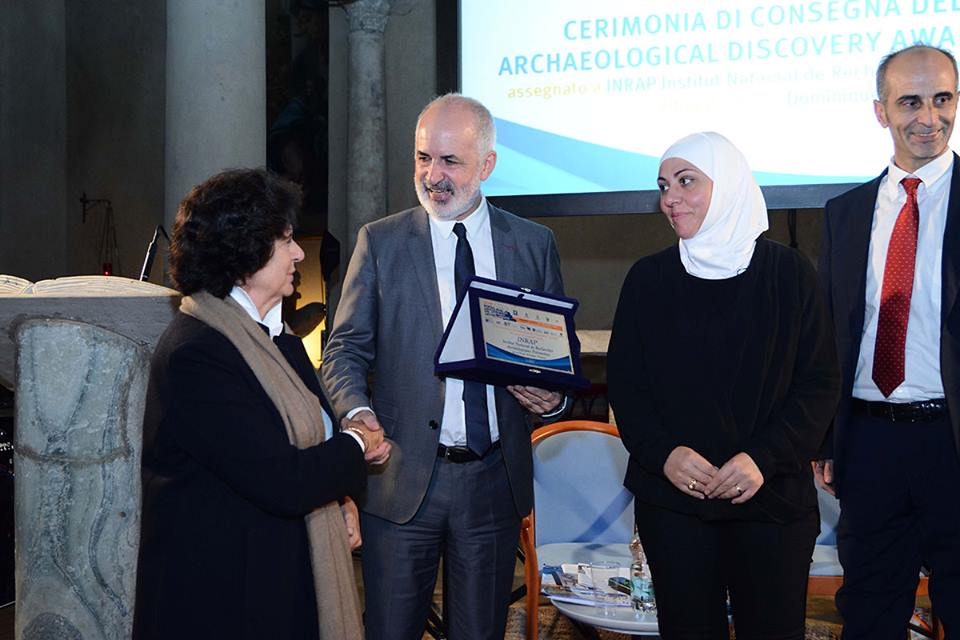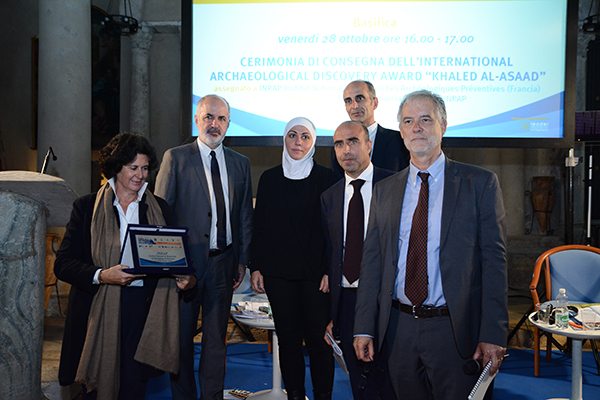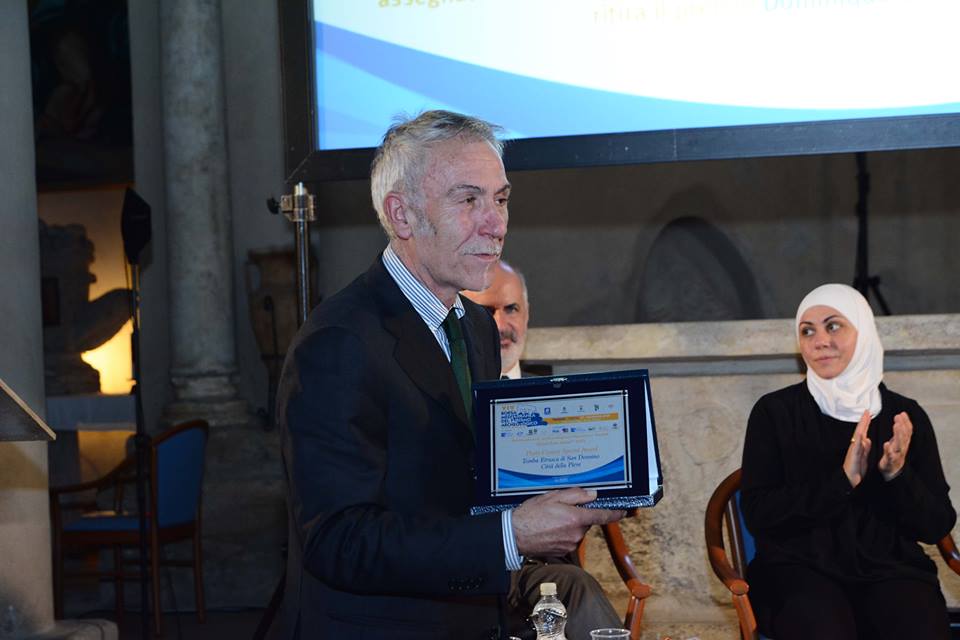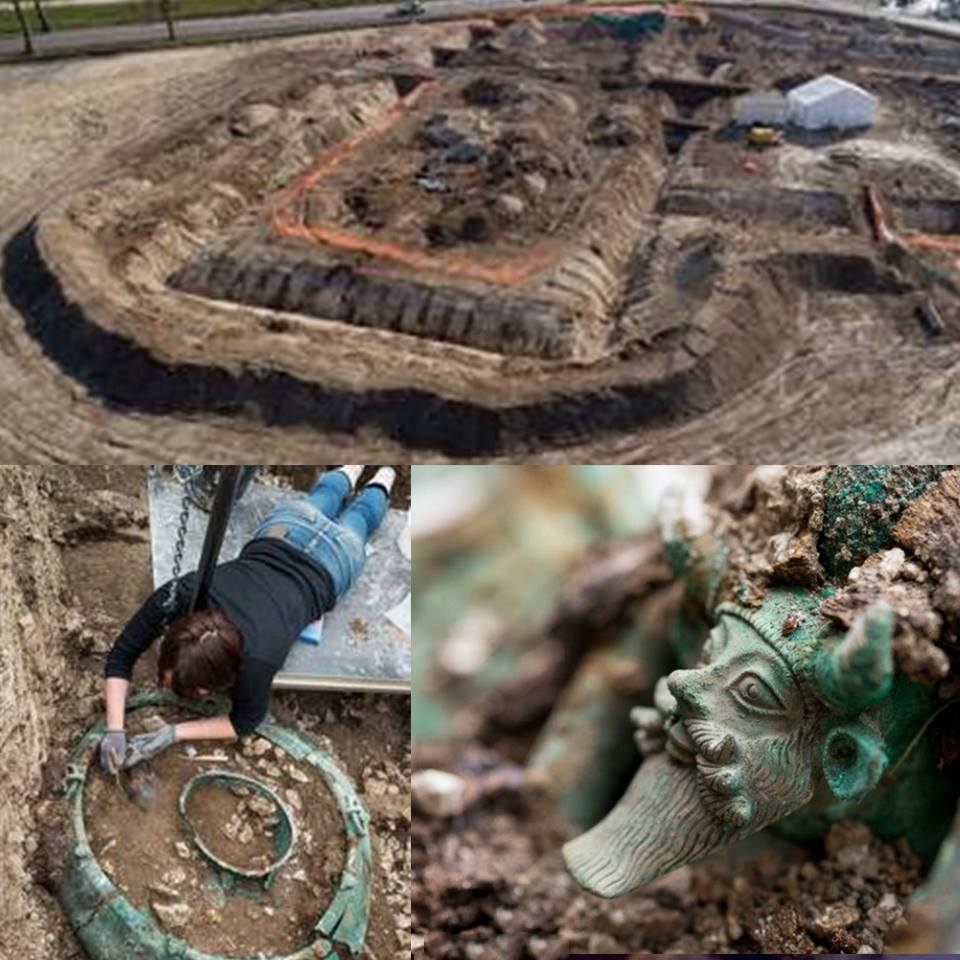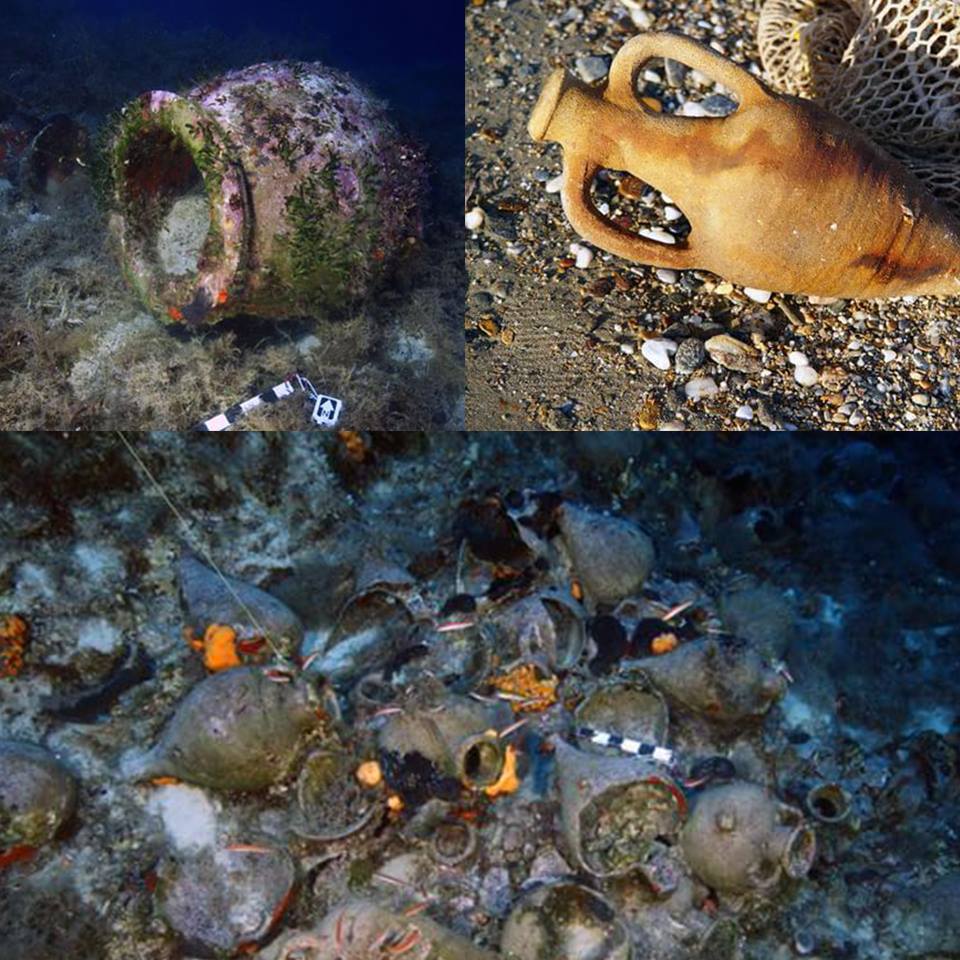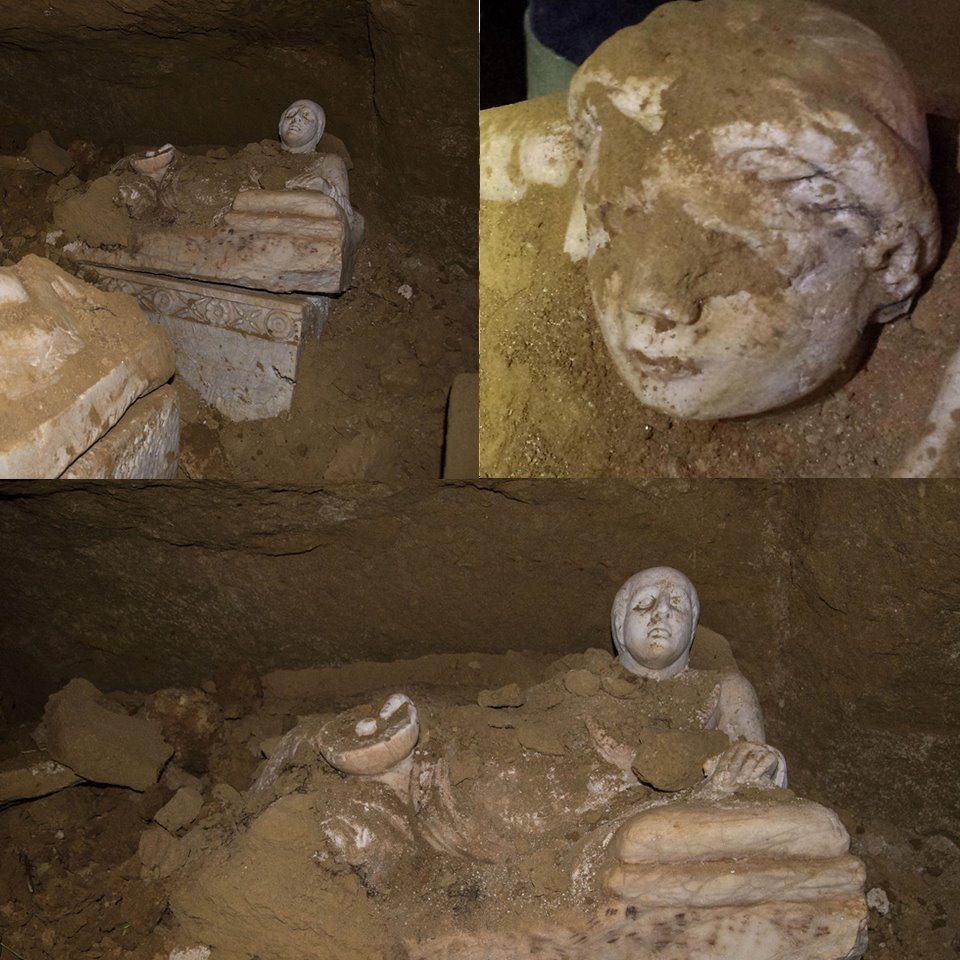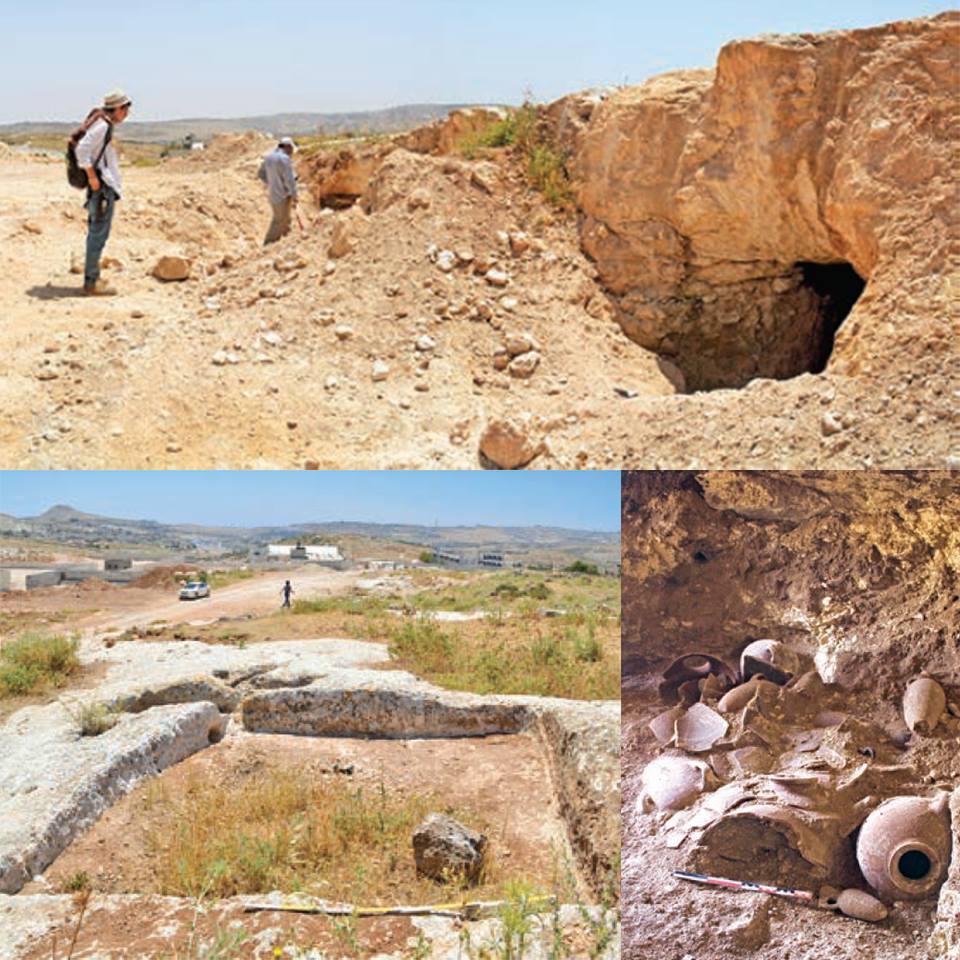International Archaeological Discovery Award “Khaled al-Asaad” 2015 (1st edition)
International Archaeological Discovery Award “Khaled al-Asaad” 2017 (3rd edizione)
International Archaeological Discovery Award “Khaled al-Asaad” 2018 (4th edition)
International Archaeological Discovery Award “Khaled al-Asaad” 2019 (5th edition)
| The second edition of the International Archaeological Discovery Award “Khaled al-Asaad” was awarded to the Celtic Tomb in France as the most significant discovery of 2015: the Prize was delivered to INRAP Institut National de Recherches Archéologiques Préventives, President Dominique Garcia, on Friday, October 28th, at the presence of Fayrouz Asaad archaeologist and daughter of Khaled al-Asaad.
The “Special Award”, the award with the greatest consensus on the Facebook page of the BMTA, is assigned to the Etruscan Tomb of Città della Pieve: a discovery of fundamental value for the territory of Pieve, which will thus become part of the network of Etruscan Cities. The five archaeological discoveries selected in the second edition were: 1. Celtic tomb in Lavau – France; |
1. CELTIC TOMB IN LAVAU – France
A tomb dating back to the V century BC and housing the remains of a Celtic prince was discovered in Lavau in the Champagne region, 100 kilometers from Paris. The news was even announced via Twitter by. French Prime Minister Manuel Valls complete with photos of the site, larger than the cathedral of Troyes. Upon the discovery of a large knife, the President of Inrap, Dominique Garcia, reported that it was probably in front of the funerary monument of a local Celtic prince. At the center of a 40-meter-diameter mound, the deceased and his altar rest in a vast 14-square-meter burial chamber, one of the largest found around the end of the early Iron Age. The tomb contains burial deposits of a wealth worthy of the highest elites of the time: basins, a bronze basket, a decorated pottery, a knife in its case. The main piece is a bronze cauldron, about one meter in diameter, adorned next to the four handles by some depictions of the head of Acheloo, a Greek river god, represented here horned, bearded, with bull ears and triple mustaches. The rim of the cauldron is equally decorated with eight lions’ heads. The artifact must be the work of a Greek or Etruscan craftsman.
Inside an oinochoe (a sort of jug) in Attica ceramic with black figures, which portray Dionysus lying under a vineyard with a female figure in front, was found: a banquet scene, a theme particularly dear to Greek iconography, exalted by gold inserts on the rim and on the base and by a decoration of the filigree handles. A testimony to how much even the Celtic aristocrats evidently appreciated banquets. Although parts of a human skeleton have been found, researchers have not yet identified the prince’s body.
Between the end of the VI and the beginning of the V century BC the Etruscan and Western Greek city-states, Marseille in particular, experienced a phase of prosperity, which led to an inward expansion to find new resources, in the form of slaves, metals or precious goods such as amber. The traders of the Mediterranean area thus came into contact with the Celtic communities distributed in continental Europe, exploiting the natural communication routes made up of rivers such as the Loire, the Seine, the Saone, the Rhone, the Rhine, the Danube.
2. 22 SUBMERGED WRECKS IN FOURNI ARCHIPELAGO – Greece
Off the Aegean, in the Fourni archipelago, a cascade of 13 Greek islands not far from Turkey, a gigantic cemetery of ships was found. The 22 wrecks, identified in an area of less than 50 sq km, are relics of the classical and Hellenistic period, datable between 700 – 400 BC and the XVI century.
The sensational discovery was made by a team of Greek and American archaeologists, coordinated by the University of Southampton, and it is providing new and interesting details on trade routes and shipbuilding techniques in the ancient Mediterranean Sea. The scholars were guided by the indications of local fishermen and divers. The wrecks cover a vast span of time: the oldest one dates to the Archaic period (700 – 480 BC), while the most recent one is from the sixteenth century. Some ships of the Classical and Hellenistic period have also been identified, however most of the boats – 12 out of 22 – belong to the Late Ancient Roman period (IV – VII century AD).
The surprise, due to the quantity of wrecks, is added to the good fortune of having suddenly seen an unexpected commercial network in the Mediterranean Sea, far from the great ports of antiquity and therefore along unsuspected routes.
The Aegean and the Black Sea, Cyprus, the Levant and Egypt, after centuries, find themselves close, as if low-cost connections already existed since time. And even scholars are surprised by the variety of cargoes, some of which have never been seen before. Not only amphorae and plates, ceramics or jars, there is also study material for naval engineering, as well as for history and art.
The archipelago, although far from important cities and valuable commercial hubs, is nonetheless strategic as a base for navigation to the east of the Aegean Sea. On the east-west axis Fourni is as much a hub as the north-south one that connects Greece with the East. Now the archaeologists are hard at work creating a 3D map of the site. Gradually, the ships, which represent 12% of the number of hulls ever found in Greece, will be brought back to the surface and placed in museums after restorations and studies. Less than 5% of the coasts of the Fourni archipelago have been plumbed by archaeologists.
George Koutsouflakis, of the Greek Underwater Antiquities Superintendency, told Science magazine: “Roman imperial sources narrate that Fourni was very prosperous with a large population and had marble mines that was exported. We know nothing of the late Roman period, as Fourni was barely mentioned in the sources of that time. ”
So far, the wrecks that have been found bear few traces of the ships’ hulls as their timbers have decayed but future underwater excavations, below the sediment, could bring new surprises. The mud may have preserved the structures from the “ravenous” attack of the lithophages and the destructive effect of the wave motion, especially on shallow waters. What intrigued the archaeologists were the heaps of artifacts scattered on the bottom from the loads of ancient transport ships.
Peter Campbell said that of the twenty-two wrecks, three have “unique” cargoes that have never been found before in the wrecks of Mediterranean shipwrecks: a treasure trove of pots from Samos, a group of huge amphorae from the 2nd century AD from the Black Sea region and other carrot-shaped amphorae from Sinop, on the Black Sea coast of Turkey.
Koutsouflakis and Campbell said they intend to return to Fourni soon with underwater robots and other wreck research technologies so they can plan future underwater excavations while optimizing resources.
3. UNDERGROUND MONUMENT NEAR STONEHENGE – England
Stonehenge, the Neolithic site used by Druids for Celtic rites near Amesbury in Wiltshire, England, has a “new” rival. About three kilometers away, at Durrington Walls, another ceremonial center dating back to the Stone Age was discovered. The monoliths, dating back to about 4,600 years ago, have been identified with non-invasive techniques such as radar towed by quads and they have not yet been unearthed.
The discovery was announced by Professor Vince Gaffney, head of the team of experts who worked on the Stonehenge Hidden Landscapes Project, created by the University of Birmingham and the Department of Archaeological Prospecting and Virtual Archeology of the Ludwig Boltzmann Institute. A few meters below Durrington Walls there are over 90 megaliths whose height must have been about four and a half meters and which made up a sort of C-shaped arena. The complex, which measures more than 1.5 km in circumference and is surrounded by a ditch about 17.6 meters deep, according to some archaeologists was complementary to Stonehenge, according to others, there was no connection between them.
Studies of the area around Stonehenge in the past had led archaeologists to believe that only this site had “studied” stone structures. But history may need to be rewritten: now there is evidence of an earlier phase of Durrington Walls, which includes the birth of the newly discovered monoliths. Their conservation is also unique and exceptional in British archaeology.
“This discovery has significant implications for our knowledge of Stonehenge and its territorial conformation – Gaffney explains – the evidence not only demonstrates an unexpected phase of the monumental architecture of prehistoric Europe, but the site could be contemporary with Stonehenge, if not a previous one. We are in front of one of the largest stone monuments in Europe. It is truly remarkable, we don’t think there is anything like it anywhere else in the world “.
4. ETRUSCAN TOMB IN CITTA’ DELLA PIEVE – Italy
Clarita Natalini (Superintendence of Umbria) and archaeologists Silvia De Fabrizio, Francesca Bianco, Benedetta Droghieri and Andrea Pagnotta, have unearthed a necropolis, whose chamber tomb consists of a room dug out of the ground and an access corridor (dromos) oriented north south and represents a uniqueness in the territory.
The quality of conservation of the finds, belonging to a known Etruscan family clan originally from Chiusi and dating back to around the III century BC, is extraordinary.
It is a discovery of fundamental value for the Pievese area, which will thus become part of the network of Etruscan cities.
The underground burial, dug into the natural ground, has a rectangular room of about 5 square meters. Inside, two large sarcophagi are visible, one of which bears a long Etruscan inscription, referable to the identity of the deceased, as well as two cinerary urns with a recumbent male figure.
Inside the urns organic materials (bones and ashes) were found, which will subsequently be analyzed by the team of the University of Pavia, which holds the most important database of Etruscan DNA. Another peculiarity of the finds concerns the material: the urns were made with alabaster marble (not local), while the sarcophagi were made with sandstone, present in the Pieve area, a sign of advanced progress within the clan itself.
The archaeological discovery, adopting innovative intervention techniques, has made it possible to preserve the color of the artifacts: one of the faces sculpted above the upper part of the cinerary urn still has painted pupils and thanks to the immediate consolidation of the color during the discovery, they will open of new studies on colors in the Etruscan era.
Among the objects found during the excavations, there was also a series of furnishings to accompany the deceased to the afterlife; a small bronze bowl, a strigil, an amphora, ceramic jars and inside the burials, a small cloth (to contain the bones) that refers to the great Homeric funerals.
5. TOMBS OF THE NECROPOLIS OF KHALET AL-JAM’A – Palestine
In May 2015, a small team of the “Sapienza” University of Rome, directed by Lorenzo Nigro and coordinated on the field by Daria Montanari, was called by the Ministry of Tourism and Antiquities (MOTA) of Palestine to collaborate in the rescue of a necropolis, discovered accidentally, during the construction of a factory conducted by a French company, about 2.2 km south-east of the Basilica of the Nativity, on the site of Khalet al-Jam’a. The joint Italian-Palestinian team has identified more than thirty still intact tombs of more than a hundred that were originally to make up the entire burial area. In addition to the plan of the necropolis, divided into four sectors (A-D) and two major cemeteries, one from the Bronze Age on the lower terrace of the hillside, the other from the Iron Age, on the upper terrace, archaeological investigations have revealed an Iron II tower and a Byzantine wine press. The rich grave goods are made up of hundreds of ceramic vases and other valuable finds.
The main feature of the Khalet al-Jam’a necropolis is its considerable temporal extension. The oldest tombs date back to the last centuries of the III millennium BC. (Ancient Bronze IV or Intermediate Bronze Age, 2300-2000 BC) and consist of wells with small underground chambers of reduced dimensions. The buried were mostly lying on their sides or lying down; the outfits were very simple, usually comprising a tetralic lamp, a cup and some jars and, sometimes, a copper dagger. It is a very common type of funerary for the time, adopted by semi-nomadic populations who lived in the various wadiat tributaries of the Jordan and the Dead Sea, very well-known from the contemporary necropolis of Jericho. What is striking, however, in the case of Khalet al-Jam’a, is that almost all the tombs were then reused in the subsequent Middle Bronze Age, thus suggesting that it served a relatively large community that had become settled.
In the Middle Bronze II-III, between 1800 and 1550 BC, the tombs have a familiar character, and are divided into several rooms, always made up of re-adapted natural cavities. The wells are generally quadrangular and above the tombs some installations called cup-marks suitable for making libations have been identified. Access to the tombs was blocked by large stones placed in correspondence with the passage between the well and the hypogeum. The deceased were placed on litters or platforms made with raw stones or bricks. The grave goods were collected in some points of the burial chambers evidently in connection with the various burials.
The vascular repertoire is characterized by some recurring forms: the large serving plates with panted feet, the ollette with marked shoulders and flared rims, the engulfed jugs, but also the large Canaanite jars with two or four handles and the drawpots, one of which it was found right in the mouth of one of these jars. Even the Middle Bronze Age tombs have returned weapons, this time in bronze: daggers, spear points and axes. Canaanite daggers are characterized by spherical knobs that were fixed to the end of the hilt made of quality calcite or chalky limestone. There are also several scarabs of the type called ‘Hyksos’ in soapstone that members of the ruling elite in Canaanite cities used as personal seals.
Some tombs remained in use even in the Late Bronze I-II (1550-1300 BC), as is suggested not only by some personal vases and ornaments, but also by a Mycenaean dagger, characterized by the large size of the head of the nails fixing the blade to the ‘handle.
The Iron Age tombs (1200-650 BC) are also hypogea divided into several chambers and house numerous buried deceased. The best-known tomb of this era, named after the family that owns the land where it was identified, ‘Barmil Tomb’, is a large hypogeum, in which materials dating back to the X century BC were found, including a jug of Cypriot-Phoenician tradition, plates and cups in Red Slip, a series of miniature jugs in black glazed ceramic.

